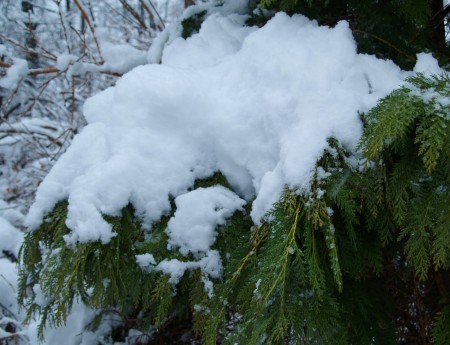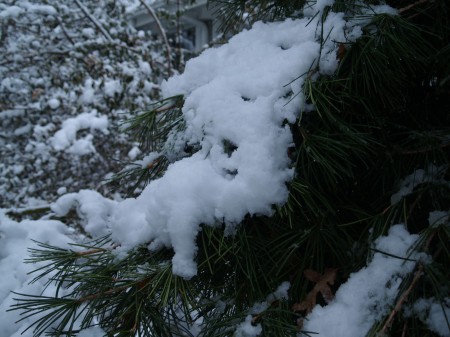Long before daylight this morning several inches of snow had fallen, and the worst of the storm is still to come. When I first went outside in the dark I was alerted to the problems ahead. Limbs of the wide spreading ‘Seriyu’ Japanese maple planted just off the corner of the garage were weighed down by snow accumulating in the dense branches to block half of the opening of the garage. As I looked across the garden the reflected light off the blanket of snow showed trouble in every direction.
Boxwoods and nandinas have been flattened by the heavy, wet snow, and crapemyrtle trunks fifteen feet tall are arched to nearly touch the ground. Unfortunately, I’ve seen this before. Now, with only four or five inches of snow there are problems. What will happen with another six, or eight, or ten inches still to come?
With colder temperatures and light, fluffy snow there is usually nothing to worry about. The wind blows, and the snow slowly drifts to the ground. But, wet snows accumulate quickly in evergreens and densely branched plants. Once the branches are bent the real danger is that they will break, and in winter storms several years ago my garden suffered substantially due to too little action, too late. Also, branches of trees and shrubs that remain bent will often loose their rigidity if allowed to remain too long, so that when the snow is gone the branches do not spring back. Many times these will require severe pruning or other actions to repair the damage.
Here’s how I plan to spend my day (after finishing this brief update).
Before the heavier snow causes more damage I’ll go outside, armed with a leaf rake. The process is not complicated from here. A gentle nudge with the rake is all that’s needed to dislodge most of the accumulated snow. Greater force can cause more damage, and most often it isn’t necessary. If winds pick up later in the day that might help to clear additional snow, but if the heavy snow that weighs the branches is allowed to remain the breezes could cause greater injury.
I’ll work on deciduous trees like the Japanese maples and crapemyrtles first, since these are most easily damaged. Japanese maples, in particular, are soft wooded with branching that is readily damaged by snow. Weeping varieties of Japanese maples are most vulnerable with a thick canopy of branches that collect the heavy snow. Extra care should be used in clearing the snow from these maples to avoid injury.
Once the branches are nudged with the rake the snow falls to the ground, and the branch usually springs back, though not all the way. This is rarely a concern when the branches have been bent for only a few hours, and I’ll worry about that another day since there’s little that can be done today. It’s not necessary to remove every bit of snow from branches, though the snow that remains will catch more of the wet snow that is predicted for later in the morning. My first snow clearing trip around the garden will probably be one of several today.
After the deciduous trees I’ll work on evergreens next, and follow that with smaller evergreen shrubs like the boxwoods and nandinas that have more flexible branches and often spring back quickly. Several years ago evergreen southern magnolias and Leyland cypresses were severely damaged in consecutive winters. A single tall cypress in my garden was bent to a severe angle and was removed. The southern magnolias have grown back remarkably, but now their form is much more wide spreading since the broken trunks resulted in more horizontal growth. I’m afraid that this will only encourage more snow to accumulate in the branches, so these will be the first evergreens to be checked.
I have a large garden, with dozens of Japanese maples and small trees scattered over the acre and a quarter property, so this task will require constant vigilance today. What happens if I ignore the snow, and see what happens? I’ve done that before, and in prior years when substantial snow falls overnight the damage is already done before I wake up.
Most often I have a casual attitude about garden chores. If I don’t pull weeds, they’ll still be there tomorrow (though they might have dropped a few thousand seeds in the meanwhile). Many garden chores can be put off, but a delay in removing snow from branches can cause irreparable damage to plants. So, I’m wrapping up my writing, grabbing my leaf rake, and heading outside. Also, while I’ve been writing it’s become light enough to see that the pace of snowfall has increased. The breeze has picked up and large clumps of snow are falling out of the tall tulip poplars and maples that border the garden.
The process of removing snow from trees and shrubs should not be vigorous exercise, and certainly is nothing compared to the labor of shoveling the driveway and walk. But, take care not to over exert, and if you are working in an area with tall trees be aware that branches could come down at any time. Avoiding damage to the plants in the garden is a much lesser concern than your personal safety, so be careful.
Note – if there’s more to this story later in the day, or in the next days I’l follow up with updates. Unfortunately, I’ve experienced this before. Fortunately, it’s March, so the snow will be gone quickly and we’ll be enjoying warm, sunny days by next week.
GOOD LUCK!! Stay warm!! franki
Thank you so much for this article! I had absolsutely NO idea I needed to watch out for my beloved Japanese maples. OK, now I’m heading out into battle, in snow gear, armed with my garden rake.
We have been doing the sa.e thing all morning. Sadly, before we got up this morning we had already sustained damage to several dogwoods and our biggest crape myrtle. They will require the chain saw once the snow is gone. For now I am worried about an arborvitae that was buried. Good luck!
By the time I got around to the southern magnolias two of the three had sustained some minor damage, and until the snow melts I on’t know if there’s more extensive injury. I think that I got to everything else before there was anything worse than bent branches. I’ll see over the next few weeks if this results in any issues, but from problems I’ve had in past years I don’t expect it to result in much concern.
Before undertaking radical pruning of damaged plants I suggest leaving things for a week or two, then rethinking the pruning or removal. Plants are quite resilient, and will often grow back much quicker than you expect.
Thank you for the reminder. We have 3 Satsuki azalea bushes out front that got smashed and hollowed out in the middle during snowmageddon that never fully recovered and look spindly. I left them alone hoping they would fill back in with sunshine, but that didn’t happen. Will they revitalize if I prune them way back and if so, how far back??
Azaleas can be cut back considerably without damage. I’m most comfortable pruning these when new growth begins, which is usually right after flowering. Azaleas can be pruned back beneath the last set of leaves, so they can be pruned severely and within several weeks there will be new growth from the bare stems. During the period while they’re cut back you should be aware if the weather is dry to be certain to water, but they should not need any other special treatment. If you want to fertilize you can do so, but it would be best to go light on it.